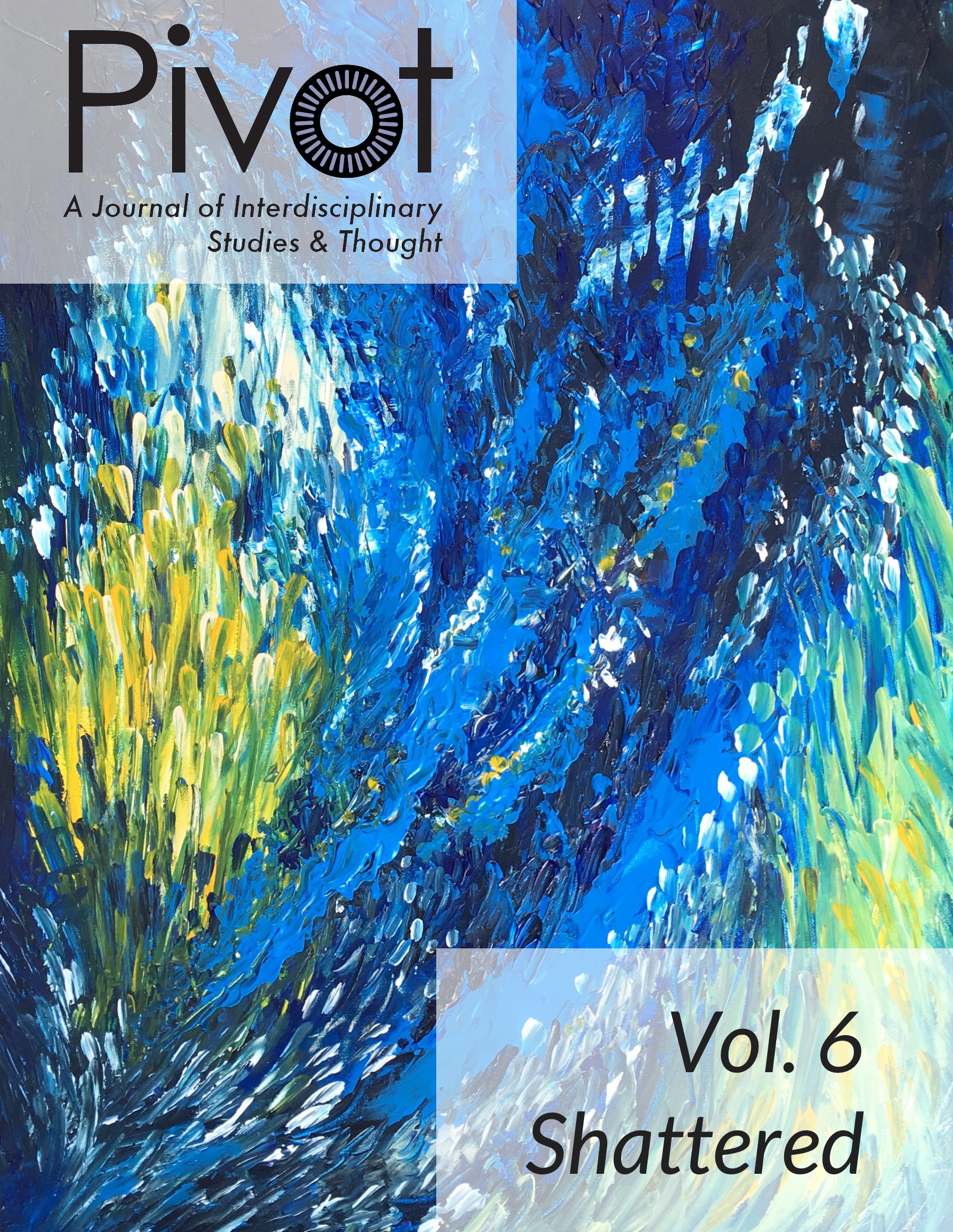Shattered Ethics: Abandoned Objects as Ethical Affordances
DOI:
https://doi.org/10.25071/2369-7326.40274Abstract
Abstract
In this essay, we explore various manifestations of shatteredness and fractalized Being. Through a dense reading of recent social theory pertaining to ruins and abandoned, abject objects, we hope to show that an appreciation of ruined, wasted materiality can contribute to generating an ethics of hospitality and corporeal generosity. To contemplate the Other, we must resist the temptation to appropriate their alterity. Rather, the irreducible alterity of shattered objects should be recognized. Objects are independent of our own intentionalities. Abandoned objects and sites constitute ethical affordances, opportunities for an ethical practice predicated upon abandoning ourselves to these multiplicities. To be is to be always already entangled in meshworks of dense meanings and significations. The ruin, far from being an impoverished site or non-place, is an excessive place rich in materiality and meaning, though its qualities are, for the most part, inaccessible to human actants. By recognizing the independence (and interdependence) of objects, we too may become hospitable agents.
Keywords:
ethics, excessive place, materiality, ruins, speculative realism, waste
References
Anton, Corey. “Agency and Efficacy in Interpersonal Communication: Particularity as Once-Occurrence and Noninterchangeability.” Atlantic Journal of Communication, vol. 16, no. 3-4, 2008, pp. 164–83. DOI: https://doi.org/10.1080/15456870802086945
Bennett, Gillian, and Kate Mary Bennett. “The Presence of the Dead: An Empirical Study.” Mortality, vol. 5, no. 2, 2000, pp. 139–57. DOI: https://doi.org/10.1080/713686002
Blanchot, Maurice. The Step Not Beyond. 1973. Translated by Lycette Nelson, State U of New York P, 1992.
Cohen, Jeffrey Jerome. Of Giants: Sex, Monsters, and the Middle Ages. U of Minnesota P, 1999.
Crang, Mike, and Penny S. Travlou. “The City and Topologies of Memory.” Environment and Planning D: Society and Space, vol. 19, no. 2, 2001, pp. 161–77. DOI: https://doi.org/10.1068/d201t
Croissant, Jennifer L. “Agnotology: Ignorance and Absence or Towards a Sociology of Things that Aren’t There.” Social Epistemology, vol. 28, no. 1, 2014, pp. 4–25. DOI: https://doi.org/10.1080/02691728.2013.862880
Dale, Karen, and Gibson Burrell. “Disturbing Structure: Reading the Ruins.” Culture and Organization, vol. 17, no. 2, 2011, pp. 107–21. DOI: https://doi.org/10.1080/14759551.2011.544888
Derrida, Jacques. Specters of Marx: The State of the Debt, the Work of Mourning and the New International. 1993. Translated by Peggy Kamuf, Routledge, 2006.
Diprose, Rosalyn. Corporeal Generosity: On Giving with Nietzsche, Merleau-Ponty, and Levinas. State U of New York P, 2002.
Douglas, Mary. Purity and Danger: An Analysis of Concepts of Pollution and Taboo. 1966. Routledge, 1984.
Edensor, Tim. “The Ghosts of Industrial Ruins: Ordering and Disordering Memory in Excessive Space.” Environment and Planning D: Society and Space, vol. 23, no. 6, 2005, pp. 829–49. DOI: https://doi.org/10.5040/9781474214940
Fischer, John Martin. “Death, Badness, and the Impossibility of Experience.” The Journal of Ethics, vol.1, no. 4, 1997, pp. 341–53. DOI: https://doi.org/10.1023/A:1009771331402
Gibson, James J. The Ecological Approach to Visual Perception. 1979. Routledge, 2015.
González-Ruibal, Alfredo. “Time to Destroy: An Archaeology of Supermodernity.” Current Anthropology, vol. 39, no. 2, 2008, pp. 247–79. DOI: https://doi.org/10.1086/526099
Harman, Graham. Immaterialism: Objects and Social Theory. Polity, 2016.
Harman, Graham. Guerrilla Metaphysics: Phenomenology and the Carpentry of Things. Open Court,2005.
Introna, Lucas D. “The ‘Measure of a Man’ and the Ethos of Hospitality: Towards an Ethical Dwelling with Technology.” AI and Society, vol. 25, no. 1, 2010, pp. 93–102. DOI: https://doi.org/10.1007/s00146-009-0242-1
Introna, Lucas D., and Martin Brigham. “Reconsidering Community and the Stranger in the Age of Virtuality.” Society and Business Review, vol. 2, no. 2, 2007, pp. 166–78. DOI: https://doi.org/10.1108/17465680710757385
Kooyman, Gerald. “Marine Mammals and Emperor Penguins: A Few Applications of the Krogh Principle.” American Journal of Physiology – Regulatory, Integrative and Comparative Physiology, vol. 308, no. 2, 2015, pp. R96–R104. DOI: https://doi.org/10.1152/ajpregu.00264.2014
Latour, Bruno. Reassembling the Social: An Introduction to Actor-Network-Theory. Oxford UP, 2005.
Morrison, Susan Signe. The Literature of Waste: Material Ecopoetics and Ethical Matter. Palgrave Macmillan, 2015.
Nielsen, Tom. “The Return of the Excessive: Superfluous Landscapes.” Space and Culture, vol. 5, no. 1, 2002, pp. 53–62. DOI: https://doi.org/10.1177/1206331202005001006
Nutman, Allen P., et al. “Rapid Emergence of Life Shown by Discovery of 3,700-Million-Year-Old Microbial Structures.” Nature, vol. 537, 2016, pp. 535–38. DOI: https://doi.org/10.1038/nature19355
Obeyesekere, Gananath. Imagining Karma: Ethical Transformation in Amerindian, Buddhist, and Greek Rebirth. U of California P, 2002. DOI: https://doi.org/10.1525/california/9780520232204.001.0001
Olsen, Bjørnar. “Material Culture after Text: Re-Membering Things." Norwegian Archaeological Review, vol. 36, no. 2, 2003, pp. 87–104. DOI: https://doi.org/10.1080/00293650310000650
Pearson, Mike, and Michael Shanks. Theater/Archaeology. Routledge, 2001.
Pétursdóttir, Þóra. “Small Things Forgotten Now Included, or What Else Do Things Deserve?” International Journal of Historical Archaeology, vol. 16, no. 3, 2012, pp. 577–603. DOI: https://doi.org/10.1007/s10761-012-0191-0
“Physicists Discover Inorganic Dust with Lifelike Qualities.” ScienceDaily, 15 Aug. 2007, https://www.sciencedaily.com/releases/2007/08/070814150630.htm.
Scanlan, John. On Garbage. London: Reaktion, 2005.
loane, Michael. “Poetry, Garbage, Gift: Assembling a Scrap Poetics in Contemporary North American Poetry.” Literature, Rhetoric and Values: Selected Proceedings of a Conference Held at the University of Waterloo, 3–5 June 2011, edited by Shelley Hullan, Murray McArthur, and Randy Allen Harris, Cambridge Scholars, 2012, pp. 85–109.
Vizenor, Gerald. Landfill Meditation: Crossblood Stories. Wesleyan UP, 1991.
Wood, David. “What is Eco-Phenomenology?” Eco-Phenomenology: Back to the Earth Itself, edited by Charles S. Brown and Ted Toadvine. State U of New York P, 2003, pp. 211–34.


